#also 47 meters down
Explore tagged Tumblr posts
Text
man it does not matter how bad the acting is or how shitty the concept is or how poorly made it is, but every single one of those like "we got stranded in this Situation and have to try to survive it otherwise we Will Die" movies stresses me tf OUT and puts me on total edge the whole time and i LOVE THEM
#im watching frozen (as in the one where the people get stuck on a ski lift not the disney movie lmfao)#and it is BAAAAD but god damn if it isnt also GRIPPING#it was also the same with that movie about the girls who want to climb that tall pole or whatever what was it called oh fall! that one#it wasnt great but omg i was enthralled the whole time#and the shallow — which WAS actually a good one#also 47 meters down#i loooooove that flavor of thriller
13 notes
·
View notes
Text
well i just found out that two-headed shark attack had not 1, but 3 sequels (they went up to SIX HEADS????) so i know what im watching over the mext couple weeks to relive my childhood
tubi also has sand sharks, deep blue sea, blood lake.... all my childhood cringy unrealistic marine life movies!! honestly. i should have looked on tubi for them sooner lmao
#youd also think that since i love (or at least used to love- we'll see if i still do) these kind of movies#id like movies like 47 meters down. but i H A T E D that film lol#ik sorry i just checked the adult animation genre TUBI HAS CAMP CAMP??? THEY TOOK IT OFF YT BUT TUBI HAS IT FOR FREE?????#genuinely. okay.#this thanksgiving. i am rewatching my old childhood favorites#just for the hell of it. i am looking through tubi and finding every last piece of my childhood that is on there okay#amber's shit you can ignore
1 note
·
View note
Text
The dialogue in this movie sounds like an arcade game
0 notes
Text
Parts of a Chinese Sword: The Jian and Dao Anatomy
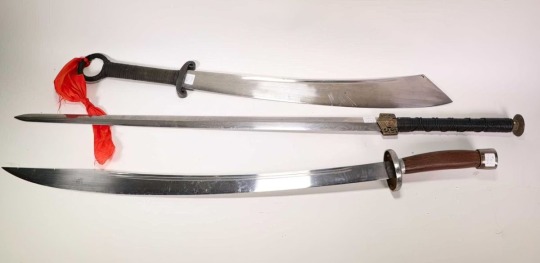
Chinese swords are very beautiful and dangerous weapons that have played an important role in Chinese history and culture for thousands of years. Their intricate design and construction are a testament to centuries of Chinese swordmaking tradition.
One must be familiar with the complex workings of Chinese swords to fully appreciate their lethality and beauty and use them more effectively in Wushu or Kung Fu Chinese martial arts. In this article, we’ll introduce you to the various components of the Dao or Jian, the traditional Chinese swords, and their use.
Parts of the Jian / Straigh Double Edge

The Parts of a Jian Sword – Credits: Mandarin Mansion Antiques
The Jian is a type of ancient Chinese straight, double-edged sword that has been valued for over a thousand years. Its blade is long and narrow, while the handle is straight and slim. Soldiers, martial artists, and academics employed the sword in ancient China and surrounding regions. Together with the staff, spear, and Dao swords, it is one of the four key weapons in Chinese martial arts.
1. Jiantan – Pommel
The Chinese word for the pommel of a Jian sword is Jiantan, and it is there that the sword begins. It’s a metal weight at the end of the handle, and its purpose is to balance the blade so the user can have a firm hold. First only available in ring pommels, Jian pommels eventually evolved into more complex designs like the metal cap, ball, or teardrop shapes and the common disk pommel known today.
2. Jian Sui – Tassel
A Jian sword’s tassel is a decorative accessory that can be fastened to the pommel or scabbard. The Chinese sword tassel is often constructed from silk. This sheath beautifies the Jian and adds a few features that may or may not improve the sword’s effectiveness in battle.
3. Jianba – Handle
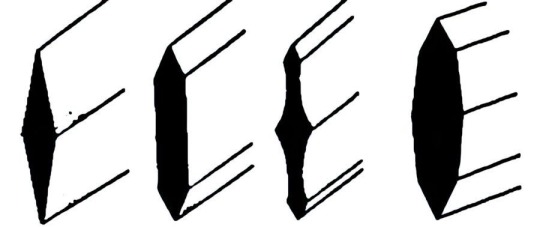
The different possible edge features on the Jian sword – Credits: Sword Buyers Guide
The Jianba is the sword’s handle, and it is always straight and slim, measuring somewhere between 6 and 10 inches (15 and 25 cm) in length. For ceremonial and combat purposes, it may be crafted from various materials, including bone, wood, horn, and even jade. The majority of Jianbas have a shorter handle designed for use with one hand, although there are also longer versions used with both.
4. Jian Ge – Guard
Traditional Jian sword guards are thin, tapered pieces of metal that can be angled in either direction relative to the blade and handle. In some cases, it can be round or square that goes between the blade and the handle. Its purpose is to shield the user’s hand from the oncoming blade and to stop the enemy’s weapon from sliding down the blade onto the hand. In some cases, it only serves as a beautiful ornamental piece.
5. Shaungxue – Hamon
A hamon is the visible line on the Jian sword that is sometimes on the blade but not always. It is a result of the differential hardening used throughout history to make the edges of the blade sharper by using clay. It is a feature most known today on the Japanese Katana.
6. Jianti – Blade
The blade of a Jian sword is narrow and long, normally measuring 23 to 31 inches (60 to 80 cm) but reaching as high as 47 inches (1.2 meters), and always tapers into a sharp blade tip. It is the only straight Chinese sword, one of just a few in the arsenal of Chinese swords, with no curving variant. The blade is forged from bronze, then iron, and finally, high-quality steel, and it is optimized for speed and accuracy when cutting.
7. Jian Ren – Edge
The straight Jian scabbard –

The sharp edges on both sides of the Jian’s blade are called Jian Ren. This Jian Ren has three sections and parts, mostly seen in the combat or martial arts type of Jian sword.
Top – razor sharp and used primarily for hacking, slashing, thrusting, but not blocking
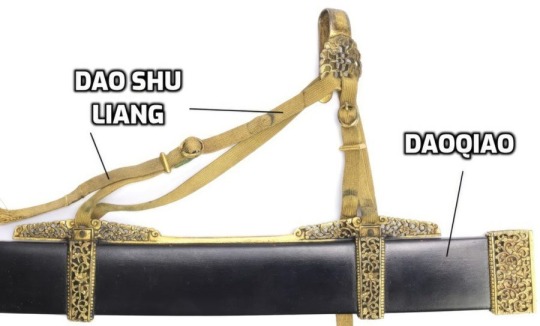
Middle – semi-sharpened part of the blade but much thicker, which is used for slashing and blocking
Bottom – very thick, sturdy, and usually unsharpened for defensive or unorthodox offensive movements
8. Jian Jian – Blade Tip
The very point of the Jian sword is called Jian Jian. It is sharpened on both sides and made to be deadly when used for thrusting and piercing, but it can also be used for slashing.
9. Jianqiao – Scabbard
When not in use, a Jian sword is stored safely in its scabbard, called the Jianqiao. It’s usually crafted from wood and covered in luxurious materials like silk or leather. Metal fittings and tassels are two examples of possible embellishments for the scabbard.
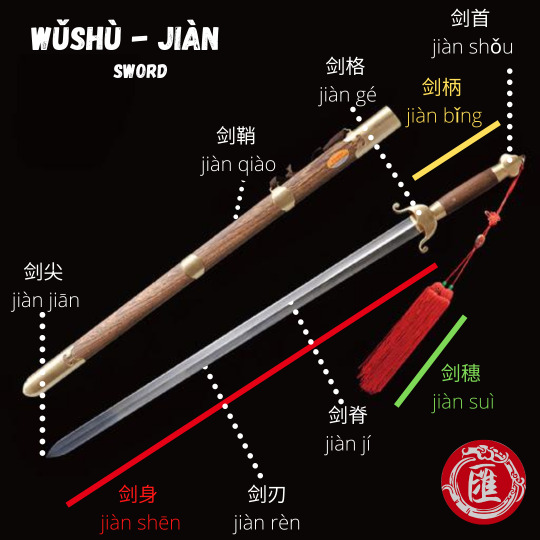
Parts of the Dao Sword (Knife/ Saber)
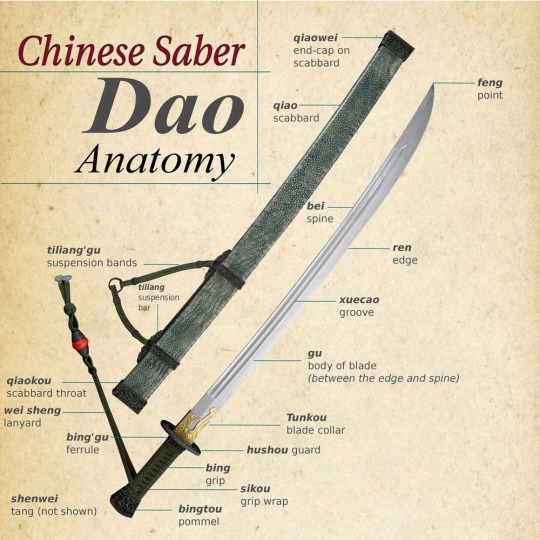
The Parts of a Dao Sword – Credits: Mandarin Mansion Antiques
The Dao sword, often called the Chinese broadsword, is a renowned blade that has served Chinese warriors for millennia. Its defining feature is a single-edged blade, which can be straight or slightly curved and may be gripped in one or both hands thanks to the long, slim grip. The Dao sword has a long history of use in numerous Chinese martial arts traditions, but it was primarily a sword of the soldier thanks to its ease of use and simpler design.

1. Daoba Dingshu – Pommel
Usually, the Dao sword has a smaller metal cap of a pommel which can be ring type, as seen in the 20th-century use of the Dadao. However, the most common type is a round or wider disc shape. It serves as a back support to the user’s hand as well as a possible blunt attack tool.
2. Lanyard and Tassel
Like the Jian has the traditional Chinese tassel, so does the Dao. But most of the time, the Dao swords have a lanyard, which is meant to have a better grip on the sword and make this curved blade more effective in mounted attacks.
3. Daoba – Handle
The handle of the Dao, which can be as small as a person’s hand or the size of the blade itself, is called the Daoba. Its most common length is 8 to 13 inches (20 to 35 cm), and it can be used with one or two hands for powerful slashing attacks.
4. Daoba Shu – Ferrule
The small metal piece just under and between the guard and the handle is called the Daoba Shu. These are often circular metal rings made for extra joining and fastening of the handle and sealing and reinforcing the wrapping material.
5. Dao Hushou – Guard
The metal piece that protects the user’s hand between the blade and the handle is the Dao Hushou. The most common type of guard seen on a Dao sword is round or disc-shaped. It offers protection to the user’s hand but is fairly limited. It makes for an excellent marching or cavalry type of guard. However, It is also featured in the parts of a Katana known as tsuba.
6. Dao Cao – Groove
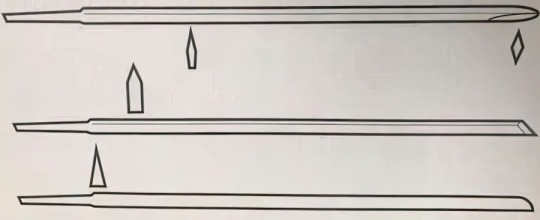
The early types of Dao Ren on the straight Dao swords, which curved with time – Credits: The Scholar General
The Dao Cao translates to saber groove and can be found in almost all types of Chinese Dao. They are sometimes referred to as blood grooves, but their real purpose is to lessen the weight of the blade so that it can increase the saber’s handling and speed. In addition, they make eye-pleasing aesthetics.
7. Dao Ren – Blade (Edge)
The sharpened side of the Dao swords, which makes them single-edged, is called the Dao Ren, which sets it apart from the Jian. This edge makes for an effective slashing tool that benefited from the curve added onto the later Dao types of swords. Thanks to the Dao Ren, these blades were easier to master and cheaper to produce, but still very effective in combat and became the main type of military sword for Chinese soldiers.
8. Dao Bei – Spine
The sturdy part of the Dao sword, which can hold off the flexibility of the edge, is called Dao Bei. This isn’t a sharpened part and can be either straight or curved based on the type of sword and can be used for defensive purposes too. Sometimes the blade can be made broader and wider, and there are instances of a spike on some Dao Beis.
9. Blade Rings
There are some cases of Chinese swords with rings placed on the Dao Bei or the blade’s spine. They are mostly for entertainment and ornamental reasons, but some say they are also beneficial in combat.
10. Tunkou – Blade Collar
An unsharpened piece of metal, usually on top of the guard of Dao swords, is called a Tunkou, which is a blade collar. This is placed for decorative purposes, mostly with traditional Chinese elements, but it also holds the blade tightly inside the scabbard, keeping it safe from the elements.
11. Dao Feng – Blade Tip
The very end of the blade is called the Dao Feng, the blade’s sharpened tip. There are cases where only one side is sharpened, but on some Dao swords, the tip is double-edged, making it ideal for both slashing and thrusting.
12. Daoqiao – Scabbard
The P-shape curved scabbard of the Dao sword – Credits: Mandarin Mansion Antiques
The Daoqiao, or the scabbard for the Dao blade, has the same features and materials as the Jian, except that it is curved. It protects the blade from outside elements and is a nice resting piece for carrying the Dao around.
13. Dao Shu Liang – Scabbard Suspension
The Dao Shu Liang is how the scabbard is different from the Jian. This tradition came from Persian influence on the west during the Tang Dynasty and is basically two ropes swinging from the blade that hold the swords in a horizontal fashion
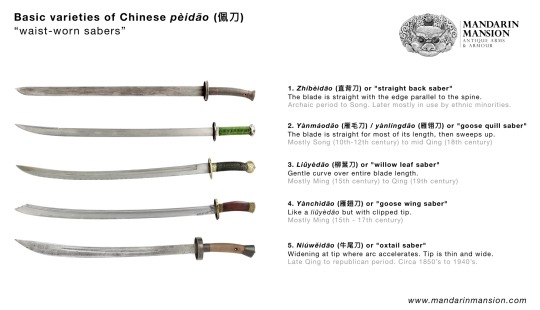
#sifu kisu#atlab#northern shaolin#lok#northern shaolim#kung fu#jian#baguazhang#atlab lok#piandao#Jian Shu#Chinese sword fighting
65 notes
·
View notes
Text
Fish of the Day
Today's fish of the day is the leopard coral grouper!
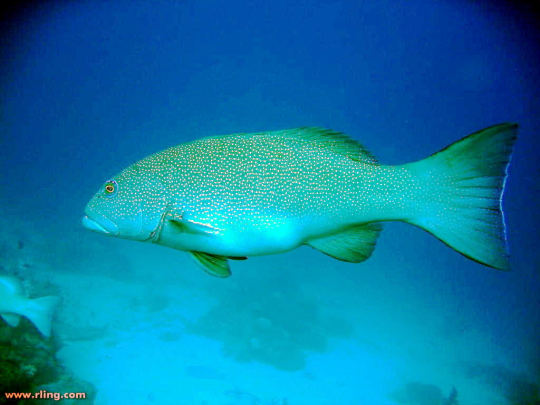
The leopard coral grouper, also known as strawberry trout and common coral trout despite not being a trout, scientific name Plectropomus leopardus is a well known marine reef fish! The most widespread fish along the barrier reef, found both from inshore to outer reefs. Found in the Western Pacific ocean stretching from Southern Japan down as far south as Sydney Australia, and a range from as far West as Thailand, and as far East as the Soloman islands. These fish live along coral reefs from depths of 3-100 meters, often living in pairs or small schools along the floor of the reef. These fish can be identified from the other common reef "trout" (these fish are actually groupers) of Australia by the small dark ringed blue circular markings, and the blue ring around the eyes, with an exhibited red, green, pink, or brown coloring depending on population.
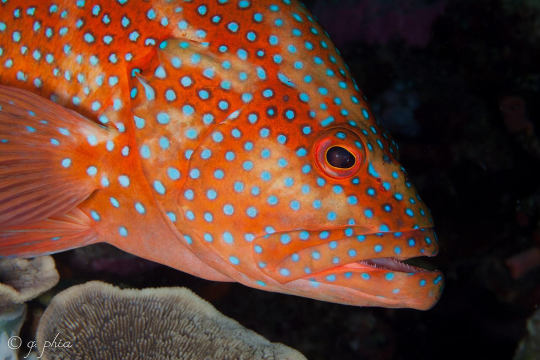
The diet of the coral grouper is made up entirely of other animals. Throughout the majority of their lifecycle, as they are mature adults, they will spend their time on other coral fish, most commonly damselfish species. Although it is very common for larger adults to cannibalize their own species and eat younger coral groupers, including their own children. These fish only feed once every 2-3 days and can hold off starvation for days to weeks at a time if hunting is unsuccessful. Hunting is done by hiding and ambushing prey from below, these fish will camouflage among the corals at the bottom of the reef, waiting for prey to swim over it for a matter of hours at a time.This camouflage is done by quick color changing on the part of the fish, with an ability to change colors in a matter of minutes to plain color or molted patterns. Other times in hunting these fish won't require camouflage at all, instead prowling schools of prey. During this time they will appear as though they are moving slowly toward the prey from an angle, and then quickly change direction of lunge once closer. This diet can allow them to get to sizes as large as 47 inches in length, but most are only 10-15 inches. Too large for most coral and carpet sharks in similar geographic range to predate on them, but some larger sharks still feed on mature adult coral groupers.
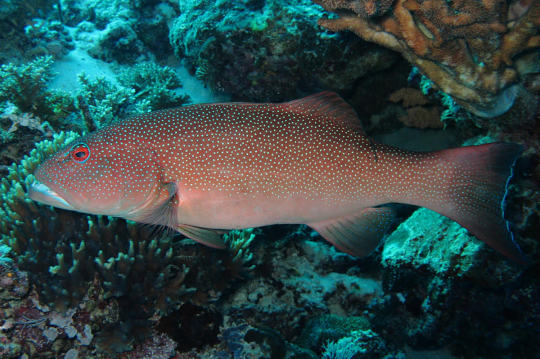
These fish, like many other groupers are protogynous hermaphrodites, these fish begin life as female and will trigger sex change later in life, although currently our understanding of what triggers it is unknown. It is believed to be related to the ratio of male to female fish on the current reef, this change occurs anywhere between the fish reaching a size of 9 inches to 24 inches, and will remain as male for the remainder of their lives. This change does not happen to all female fish that get that large, but it is more common for large coral groupers to transition and for smaller fish to remain female. Once a fish has transitioned to male (a process that can take anywhere from 2 weeks to 2 months) these fish become incredibly territorial,
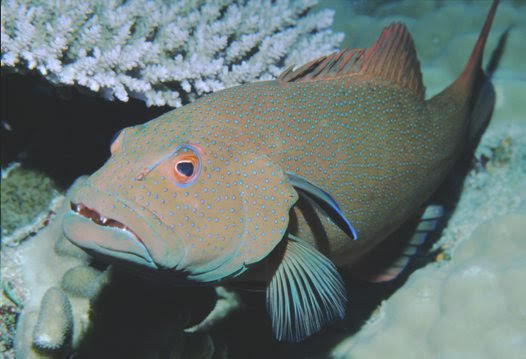
Between September and December, when it is late spring and summer in the southern areas this fish calls home, the coral grouper is spawning in the North barrier reef, whereas those in more Southern areas, spawn in October to February. The coral groupers in this area will form dense groups at steep slopes of the reef, spawning at a peak of the new moon and at dusk when the light is low and predators are less active to prey on released eggs. These tight groups of fish are formed as a male chooses an area to defend and entice females into his territory with a courtship ritual. This ritual is made up of a male repeatedly darkening and displaying their fins darkened edges, which they change the color of quickly. If a female accepts they will swim in circles toward the surface releasing sperm and eggs before splitting ways. These fertilized eggs will be released into the water stream and larvae will develop in the nearby reefs, becoming fully formed and hunting fry at an age of only 5 weeks. After this, maturity is based on size rather than age itself, and they'll live a long and full 16 years on average unless predated on.

That's the leopard coral grouper, everybody! Hope you have a wonderful day!
#fish#fish of the day#fishblr#fishposting#aquatic biology#marine biology#freshwater#freshwater fish#animal facts#animal#animals#fishes#informative#education#aquatic#aquatic life#nature#river#ocean#Plectropomus leopardus#leopard coral grouper#strawberry trout#common coral trout
33 notes
·
View notes
Text
jules’ masterlist *ੈ✩‧₊˚




last updated 6/17/24
kate and nika gif by @/captainmartin20
this includes all of my complete works :3 everything here is MINE do not steal or we finna have issues… i do write rpf and if that isn’t your thing, feel free to scroll. just don’t leave any hate on my profile. it isn’t a space for that. also please check my request status before you send something in.
just know that anything you socially consume on my page, i am not responsible for what you get offended by or whatever triggers you. your internet consumption is your responsibility. i will not take fault in anything related to what you see from me.
💌 fluff 🔞 smut
yellowjackets
lottie matthews
🔞| impatient
💌| yikes
🔞| as cold as ice
💌| tie me down
🔞💌| jealous lottie hcs
💌| shy lottie hcs
💌| lottie and skater partner hcs
shauna shipman
💌🔞| cowgirl!shauna hcs
💌🔞| gf!shauna hcs
wcbb
kate martin
💌| after the storm
🔞| favorite bad decision
🔞| just for you
💌🔞| gf!kate hcs
series
💌| no hard feelings
💌| one more?
nika mühl
💌🔞| gf!nika hcs
🔞| smutty!nika hcs
paige bueckers
in the works…
georgia amoore
in the works…
hailey van lith
in the works…
misc
mia (47 meters down: uncaged)
💌| perfect pair
74 notes
·
View notes
Text
Last year, Kasai Jun was interviewed as part of the interview project DEATH, which interviews various people about death in order to find a better understanding of how to live and appreciate life.
I thought it was a fascinating interview, so I decided to translate it.
Please go visit the original interview - the photography accompanying it is absolutely gorgeous.
Also, please don't repost this whole translation elsewhere. If you want to quote an excerpt of my translation for something, please make sure to also credit the original team behind this interview and link back to the original interview.
Deathmatch Fighter Kasai Jun - 4/27/2022

“It’s not a deathmatch until you return home alive” The reason this 47 year old Charisma Wrestler continues to shed blood in the ring
Within pro wrestling, there is a genre called “deathmatch.”
An extreme set of rules that allows deadly weapons and has no disqualifications. Brawls with fluorescent light tubes, and dives onto barbed wire boards. Without hesitation, wrestlers stab their opponents in the head with fistfuls of bamboo skewers. When wound-covered bodies violently collide, shards of glass and sprays of blood shower the ringside seats.
Upon first seeing it, surely everyone thinks “Why are these people hurting each other like this?” “What the hell am I looking at?”
This is the world of the man known as “Charisma,” professional Wrestler Kasai Jun of the independent promotion Pro Wrestling Freedoms.
In November of 2009, he had a “razorblade board plus alpha deathmatch” against Ito Ryuji in Tokyo’s Korakuen Hall. Kasai, 35 years old at the time, dove from the second floor balcony, a fall of 6 meters, onto a table, aiming for his opponent Ito.
Afterwards they continued to fight with various weapons, in a match that concluded 15 seconds before the 30 minute time limit. That year, this match was awarded the Best Bout award. And Kasai, the winner of that match, became a living legend overnight.
12 years have passed since then. Kasai is now 47 years old, and he continues to rule over the world of deathmatch wrestling. Under the weight of many literal life-or-death battles, Kasai’s body no longer moves the way it did when he was young. Even so, why does he continue to set foot in such a dangerous place?
We asked “Charisma of Deathmatch” - a man who makes the crowd go mad in the space between life and death - about his views on death and on life.
Desiring to truly feel alive
- Normally, people try to avoid pain and suffering. Kasai, why do you continue to shed blood in the ring?
Hahaha. From an outside perspective, you must really wonder “Why do you keep doing something so painful” huh? That’s a normal way to feel. But from the wrestler’s perspective, it’s completely different.
In your normal daily life, do you ever feel like “Ahh, it’s so glorious to be alive”? You’d almost never unconsciously blurt out something like that.
But in a life or death battle in a deathmatch ring, after you step down from that ring, that’s exactly what you feel. “Ahh, I’m alive. I’m so grateful to be alive.” Because of that, I can’t quit.
Mountain climbers and stuntmen probably feel like this too, don’t they. Stepping into a situation where their life could end, and returning home safely. I wonder if they’re searching for that feeling of being “truly alive.”
This feeling is passed on to the audience too. Fans often tell me “Watching Kasai Jun’s deathmatch gives me the strength to continue forward.”
They say things like, “I’m being bullied at school so I wasn’t going to go any more, but now I feel like I can keep going.” Or, “It’s exhausting to keep going to work, but after seeing Kasai persevere while shedding blood in the ring, I can persevere and keep going to work.”
Recently I can’t do this much because of covid, but in the past when I’d sell merch, fans would often say things like this to me.
Because of this, it seems to me that deathmatch wrestling is simultaneously a way for wrestlers to feel truly alive, and a way for those who watch it to feel more positively about living.
- Because of the sensational way “death” is shown in the ring?
Probably, yeah. Because it looks like we’re doing something really painful.
But don’t get me wrong. We aren’t in a particular hurry to die. And we aren’t wasting our lives either. What I always say is, “It’s not a deathmatch until you return alive.”
[Note from me - this phrase (生きて帰るまでがデスマッチ) is a play on a well-known Japanese phrase 家に帰るまでが遠足 “The field trip isn’t over until we return home.” This started as something a teacher would say to students in their care, and Kasai has altered it into his motto towards both himself and other deathmatch wrestlers.]
- It’s not a deathmatch until you return alive.
If you get in a ring where you might die or get seriously injured, and you do die, or you do get seriously injured, you’re no different than a rank amateur, right? But a guy who dives into a deadly dangerous situation and returns from that ring unharmed, he’s the absolute greatest and the absolute coolest.
Like a stuntman, right? If he returns home alive, people say “amazing,” but if he dies, he’s no longer a pro.
At 35 years old, his view on life did a complete 180 during a match
But, when I was young, I thought about it completely differently. I never thought “I’m grateful to be alive.” In the ring, I did dangerous stuff and defeated my opponents. I just thought of it as my job.
The more dangerous stuff I did, the more people said “Kasai is amazing!” That felt really great. Every time I stepped into the right I thought, if something goes wrong and I die I guess that’s how it goes. I thought “Deathmatches should be a memento mori.”
- What caused such a big change in your values?
That match against Ito Ryuji in Korakuen, in 2009. It changed my mental state by 180 degrees.
The truth is, I went into that match thinking “This is my last match before I retire.” Because it was my last match, I would do everything I wanted to do. Win or lose, I went into the ring thinking “I’ll retire.”
But during the match, my feelings completely changed. I thought “If I quit like this, I’ll be half-dead.” There’s nothing else I want to do, and I’ve never felt joy like this anywhere else. It was just too much fun.
So, after the match ended with 15 seconds remaining, I announced my decision to continue wrestling. “I was thinking of retiring but, I’m gonna keep going.” That’s what changed.
- Since your values have changed so significantly from when you thought it’d be good to die in the ring, what’s your “ideal death” now?
Spending the day with my family as I always do, watching tv with an after-dinner drink as I always do, getting comfy in my futon as I always do, and passing away. That’s the best death, isn’t it.
I’ve said it before but, people who say “It’s my ambition to die in the ring” are just trying to look cool. For a pro, it all comes down to returning home alive. And so, I believe that when the life of Kasai Jun the human being comes to an end, Kasai Jun the wrestler will die as well. I want to be a pro wrestler until I die. That’s how I feel now.
When I was young, I thought the best time for a wrestler to retire was when he could still move, when people would say “It’s a shame, because there’s still more he can do.” But if that’s true, I’ve already missed my best time to retire.
Since I’ve come this far, maybe it’s better to keep doing this until my death. Since around the time I turned 40, I started thinking this way.
Gaining years = leveling up. I’ll reach my peak just before death.
- Since you’ve been doing this for so long, it’s inevitable that your body has become weaker. Kasai, how have you dealt with aging?
The word “elderly” is a concept created by human beings, isn’t it? Since that’s the case, I believe it’s something we can absolutely overcome. I don’t think increasing in age is the same as becoming elderly.
Look, it’s true that my physical stamina has decreased and my muscles have gotten weaker than they were when I was younger. But my will and my spirit have continued to grow. Instead of just breaking even, I think I’ve leveled up. 47 years old is level 47. I now see growing older as a positive, like leveling up every year.
Because of that, my peak has yet to come. I’ll reach my peak just before I die. I’ll be at my strongest just before my death. That’s the ideal I envision for myself.
There was a time when I felt insecure about my age. When I hit my mid 30s, I hated that my body was becoming weaker.
But then, while drinking at home and watching a documentary on TV about (rock musician) Yazawa Eikichi, I realized something. “If you think about it, uncool young people are uncool, and cool guys are cool even if they’re old.” Since then, my way of thinking changed. I started calling getting older “leveling up” at around that time.
[Note from me: Suzuki Minoru also refers to getting one year older as “leveling up” in the exact same way. They are friends, so I assume Suzuki got it from Kasai.]
- I'm surprised that a pro athlete who uses his body as a weapon would think of aging in that way.
Pro wrestling and deathmatch are unique among sports. Unlike say, track and field, or swimming, it isn’t a competition where every second counts. I can’t move the way I could when I was young any more, but through my facial expressions, pauses during matches, and so on, I have many ways to express myself.
A guy can be handsome, macho, with great muscles, and completely suck as a wrestler. In contrast, a guy like me who’s ugly, short, and middle-aged, can get support from the fans. It’s a completely different genre, and that’s what makes pro wrestling so interesting.
- What about your emotional struggles? In your documentary film you said you were having some difficulty maintaining your motivation, which you described as “Deathmatch Erectile Dysfunction”
Yeah, well, that can definitely be a problem. When you’re young, you’ve just got piles of hopes and dreams and things you want to do. But as the years go on, and as you accomplish those things, you can kind of get lost.
What’s helped me increase my motivation has been the existence of people who make me think “I absolutely don’t wanna lose to this guy” or “I don’t want this guy to take all the best stuff for himself” In my case, for example, that’s been (fellow PW Freedoms deathmatch wrestler) Takeda Masashi. Or, although he’s from another organization, New Japan Pro Wrestling’s El Desperado.
That’s why for the past 3 or 4 years, I’ve been asking people to “stimulate me.” I want intimidating people to keep approaching me. Well, on the other hand, if they take the most delicious part for themselves, that’s a problem.
A fear of death led to a “selfish life”
- Incidentally, perhaps it’s too late at this point, but do you worry about being injured or dying?
I said it already but, “It’s not a deathmatch until you return alive.” Since I’m a pro, I have the skills required to do this without death or injury.
But, it’d be a lie to say “I’m not afraid.” Even now, for several days before a match I get so stressed that I can’t sleep. Despite how I look, I get plenty scared. Much of my life has been driven by a strong fear of death.
- How do you mean?
It sounds silly, but when I was in grade school I believed in “The Prophecies of Nostradamus.” Have you ever heard of it? “In the year 1999, all of humanity will be destroyed.” Every night I shook with fear in my futon, thinking that my life would end at the age of 24.
Propelled by that fear, I concluded, “If the earth is gonna get destroyed anyway, I should quit studying. Instead I should use the rest of my remaining lifetime to do stuff that I like.” I completely quit studying, and instead spent all my time watching pro wrestling, which I loved.
Conversely, my fear of death also led me to become a pro wrestler. After graduating high school, I got a job in Tokyo as a security guard, but I gave into temptation and visited brothels daily. One day I happened to be reading a magazine with an HIV checklist inside, and almost every item applied to me.
At that time, I still thought “AIDS = death” so I thought “Oh, this is AIDS.” “Oh, this is how I’ll die.”
Luckily, when I got tested the result was negative, but after preparing myself for death, I thought “I really should do what I want” and knocked on the door of Big Japan Pro Wrestling. My life has always been influenced in this way.
- I get the impression that many wrestlers die at an early age. Since then, your fear must have increased.
Nah, that’s not really true. I’m surprisingly practical about the deaths of others. I just accept it, like “That’s the kind of life you lived.” I suspect my fear of death isn’t a fear of death itself, but a fear of becoming nothing.
- A fear of becoming nothing.
I’m no (actor and spiritualist) Tanba Tetsuro, but if after you die, you go to the spirit world, and cross the Sanzu river, that’s not all that scary is it? I wouldn’t go so far as to say “it’s fine if I die” but there’s some kind of hope or meaning. But if “After death, you become complete nothingness” “After death you feel no joy or sadness” I think that’s really scary.
But these days, I don’t experience that fear of death as much as I used to. If after this interview a dump truck hits me and I die, I wouldn’t have any regrets. I could say I did what I wanted to do.
Pro wrestling is a business where you depend on your popularity with an audience, but I’ve never tried to flatter the audience to get sales or support, or thought about how to increase my popularity. Ultimately, Kasai Jun puts himself first. I’m my own number one.
To die without regrets is to win at life
- But, if someone wanted to imitate your way of life, I think most people would be profoundly afraid of not getting by financially, or of being rejected by society. Why do you think you remain stoic in the face of such fears?
What’s there worth imitating about me? If you’re selfish like me and you can change it, you should want to!
But, this is probably related to that “fear of becoming nothing” I mentioned earlier. Ever since I was little, I’ve thought stuff like “This whole world isn’t real” and “Maybe all of this is just a dream.”
Nothing in this world is certain. Since that’s the case, all you have are your own body and your own feelings. In short, I don’t believe in anything but myself, so I put myself first.
- So in order to “feel truly alive” you throw yourself into the painful world of deathmatch wrestling, which leads us back to where we started.
That’s right. I guess you could say that pain is the only thing I believe.
But when I was young, I did understand the fear of not making enough money to survive. When I was around 30 and my son had just been born, I was seized by that fear.
Really, I was broke, and I couldn’t even pay into the National Pension Fund like I was supposed to, so I went to the ward office and said “I do intend to pay, so please wait a little.” I thought to myself, “Living is so expensive and so difficult.”
- A deathmatch fighter scary enough to quiet a crying child, with such an everyday problem.
Three years after my debut, when I was around 27, I was badly injured. I quit Big Japan, and after a year’s absence, I transferred to a different group called Zero-One.
Zero-One was founded by ex-New Japan Pro Wrestler Hashimoto Shinya, and the pay was good compared to Big Japan, and they held a lot of shows, so I could wrestle frequently. The environment there was very pleasant.
But, due to the policy of the organization, I couldn’t do the deathmatches that I love. During that time as a “salaryman wrestler,” I survived, but I think deathmatch fighter Kasai Jun, pro wrestler Kasai Jun, was completely dead.
“I really should do the pro wrestling I want to do,” I thought, and I quit Zero-One, and persisted with the pro wrestling that I love. Maybe that’s why I feel like I can now “die without regrets.”
Ultimately, if you live your own life as you wish, and think “I have no regrets” when you die, you win. Maybe people today have lost sight of the essence of what it means to live. It’s fine to work hard at your job, but if you’re spending every day miserably, is that kind of life really okay with you?
I’d rather live for 20 years and laugh every day than live for 100 years and never smile. If you’ve lived for 100 years and never laughed, that’s the same as being dead, isn’t it?
~
写真:本永創太 ~ Photographer: Motonaga Souta
執筆:鈴木陸夫 ~ Author: Suzuki Atsuo
編集:日向コイケ(Huuuu)~ Editor: Hinata Koike (Huuuu)
#kasai jun#jun kasai#pw freedoms#pro wrestling#deathmatch#my translation#This is definitely the longest thing I have ever attempted to translate!#I've got nobody checking over my work or anything like that so as always apologies for any typos or errors that I didn't catch
310 notes
·
View notes
Text
The strawhats in Horror/Thriller movies

Since it's October and Halloween is around the corner, I just want to write something to get into the spirit.
Luffy:
If it was an haunted house type of movie and one of the doors close all of a sudden, his dumbass will investigate it.
If he was running from a slasher, good luck to the killer because Luffy will not go down without a fight.
He will also be the person trying to save their friends lives despite the odds.
Overall, I don’t see him dying at the end because he’s very lucky.
Zoro:
You know how in Scream, the iconic phone call where Ghostface is hiding in the house with the victim looking for them?
That’s not gonna happen with Zoro because his ass will get lost too.
Like imagine him being trapped in a haunted house and not being able to leave because he keeps getting lost. The demons just staring at him like “Wow. We don’t even have to do anything."
Like Luffy, Zoro is willing to fight and it’s over once he got his hands on a knife. Unless he’s up against a ghost.
If he dies, then it’s either because the villain was one step ahead of him or sacrificing himself to save his friends.
Nami:
She’s definitely “The last girl”
In a horrific situation like this because of bad luck on her part.
For example her car breaking down, being forced to go in a haunted house because of Luffy, etc.
She would struggle with the antagonist here and there but will reply on her brains to get out of the situation.
You know those moments where the “final girl” would come up with a plan and even fight the slasher? Yeah that’s Nami.
Overall, I think she will live.
Ussop:
*Door closes*
*Ussop moves out*
*credit rolls*
He's not playing around, if one thing were to go wrong, he’s running out of there.
If you watch “Night of the demons” then you remember Roger who was running away from the demons throughout the movie. That boy would not stop for nothing and escapes at the end.
That’s Ussop right there.
If somebody were to suggest going to a abandoned house, that man is the first to say “No.”
So Ussop will live with no problems.
Sanji:
If the slasher is a girl- RIP Sanji (1999-2024)
But other than that I think Sanji would be a reliable character in the cast, sensing something not right.
Though I think he will probably die like Zoro because the villain was one step ahead of him.
But before he died, Sanji figured out how to defeat the ghost/slasher which will help the other characters.
(His Mr.Prince side is showing)
Chopper:
He will live because he’s a child
Definitely the first one to sense something is off but will live in the end due to good luck
Robin:
I think she will star in a more psychlogical horror movie.
Either way, Robin will be the character to do all the detective work and never lets her guard down unless she gets too invested into her findings
She will live unless the movie plottwist was that she was already dead from the beggining.
Franky:
I think he will be in a horror comedy movies
I can see him being a supporting character and suprising the main cast by dectecting the ghost with his inventions.
He will hit the movie with funny one-liners and stuff.
Brook:
He would be in a broadway rather than movie.
I mean he already got the looks and the humor too.
I can see his songs being the most popular when the movie's soundtrack is released.
Jimbe:
Okay back to the serious stuff.
Jimbe would most likely be in those thirller movies that involves animals like Jaws, Orca, 47 meters deep, The meg, etc.
He would be the old man that knows how to take down the animals with his tactics.
50/50 chance that he will die but at least he took the animal down with him.
#monkey d. luffy#roronoa zoro#one piece nami#usopp#vinsmoke sanji#Tony tony chopper#nico robin#one piece franky#one piece brook#jinbei#one piece
23 notes
·
View notes
Text
A Writer's Odyssey (刺杀小说家) | Cmovie | Whump List

Genre: Action, Thriller, Mystery, Fantasy, Historical.
Synopsis: Desperate to find his missing daughter, a father agrees to help a mysterious woman assassinate a novelist. At the same time, the young hero in the book’s alternate universe has also put his revenge plan into motion, and his actions begin to affect the real world.
Length: 2 hours
Whump meter: ▲▲▲◭△
✨ Both the fantasy world and the real world had an engaging story that connected very nicely! Very unique and surprisingly whumpy ✨
⚠️Trigger Content: Quite a bit of blood, human trafficking (briefly in the beginning). ⚠️⚠️Some SPOILERS will be found, proceed with caution⚠️⚠️

Whumpee: Lu Kongwen portrayed by Dong Zi Jian
10:20 | (as book character) Chased through a forest, hit in the back with chains, falls to the ground, grunts, bleeding from the mouth, struggling to continue running, saved, pushed off cliff to save his life. Panting, whimpering, in shock, watching loved one die, whimpering, crying, angry.
16:16 | (as book character) Living armour engulfs him, in shock, trying to remove it, falls to the ground, in pain, unable to control his limbs, whimpering, armour pierces his skin and settles on him, whimpering, groaning, screaming.
35:15 | (as himself) Barely dodges being hit by a car, tumbles down the stairs, wincing.
41:05 | (as book character) Accidentally dragged into war, barely dodges an arrow shot at him, falls to the ground, in shock.
55:55 | (as book character) Scared, running for his life, chased. Falls on the ground from a rooftop, barely dodges a weapon thrown at him. Kicked in the chest, knocked back onto the ground, barely dodges a weapon thrown at him again, bleeding from the mouth, scared, struggling to get up, concern for ally.
01:01:05 | (as himself) Hit in the leg with a rock, falls to his knees, wincing in pain, labored breathing, hit in the shoulder with a rock, whimpering, calling out for help, panting, struggling to crawl to safety, hit in the back with a rock, groaning, hunched over in pain, whimpering, hit in the head with a rock, falls down a hill, unconscious on the ground, bleeding from the head, groaning weakly.
01:11:35 | (as book character) Clutching chest, coughing, concern for him.
01:20:45 | (as himself) Scratches visible on his face. Slips and falls off building, caught by ally.
01:21:48 | (as book character) Fought, saved, distressed. Holes visible on his arms from meat armour. Meat armour returned to his body, stumbling, panting.
01:44:50 | (as book character) Holes visible on his arms, saved, knocked back onto the ground x3, in pain, saved, grabbed by giant hand and squeezed, bleeding from the head, groaning, screaming, saved, falls to the ground, writhing in pain, stabbed in the abdomen by a giant nail, slowly dragged across the ground, groaning.
01:49:50 | (as himself) Stabbed (off-screen), lying on the ground, barely responsive, bleeding from the abdomen, wheeled into the hospital, oxygen mask on his face, unconscious.
01:53:25 | (as book character) Struggling to walk, shoved and is sent flying back onto the ground, spits blood, groaning, panting. Clutching arm, tries to move but arm hurts, winces, tries grabbing sword but arm is too weak (seemingly dislocated but unsure when this happened), winces, armour engulfs his injured arm, groaning.
01:5920 | (as book character) Dangling from high place, struggling, engulfed by tentacles.

Whumpee: Guan Ning portrayed by Lei Jin Yin
05:35 | Arrested (offscreen). Has nightmare of losing his daughter, wakes up cuffed to the car, repeatedly hit.
35:15 | Saved from car driving into him, tumbles down the stairs, wincing.
47:00 | Kicked in the chest, punched in the chest, shoved into a wall, kneed in the abdomen, shoved into a furniture, strangled with a telephone cord, kicked on the leg which causes him to fall onto the ground, arm twisted behind his back, screams. Held under water in a bathtub, arms bound, struggling, losing consciousness, pulled out and thrown on the ground, coughing water, labored breathing.
01:06:15 | kicked in the chest, falls back.
01:05:12 | Fought, glass bottle broken over his head, bleeding, slashed in the face, falls on the ground, wincing, struggling to get up, angry. Told disturbing reveal, whimpering, crying. Kicked to the ground, tackled and knocked out. Crying.
01:33:50 | Electrocuted x2, fought, crashes into bookcase, slashed in the back with a fan blade, clutching leg, trail of his blood on the wall.
01:39:05 | Golf ball thrown at his abdomen with super strength, punched into a wall, thrown onto a table, dragged across the floor, unable to get up, bleeding from the head, falls to the ground.
01:49:30 | Helped to walk, struggling to continue on his own, stumbling.
02:01:30 | Emotional, crying.
── ⋅ ⋅ ── ⋅ ⋅ ── ⋅ ⋅ ── ⋅ ⋅ ── ⋅ ⋅ ── ⋅ ⋅ ── ⋅ ⋅ ── ⋅ ⋅ ── ⋅ ⋅ ── ⋅ ⋅ ── ⋅ ⋅ ──
Gifs coming soon >:3
#asian whump#whumplist#whump list#whump#cmovie#chinese movie#a writer's odyssey#刺杀小说家#lei jin yin#lei jinyin#dong zi jian#dong zijian
35 notes
·
View notes
Text
What I’ll do 2 |Jey Uso


Synopsis: Things change, people change and we all make mistakes, what matters is what we do to fix them.
Warnings: Nothing
📢: I know the teaser alludes to knowing who the mystery person is but I ended up changing it but it’ll still be the same drama.
Please like and comment and all feedback is welcome enjoy
Also not proofread but what’s new
1

A few months later
Cleo and Joshua have been having a nice period between the two of them, they’d hang out at each other’s houses have mind blowing sex and really stayed under each other.
They honestly acted like a couple and when in public they often got mistaken for one. They’d laugh it off and say thank you but it had Cleo thinking about what they were actually doing.
Were they together unofficially?
Were they just friends who fucked?
But she wasn’t going to be the one to ask lying down, with Jeys arms around hers in his bed, 47 meters down uncaged playing on the big screen television.
Feeling something burning into the side of her head she turned her head to see Joshua, quickly snap his head away from her, causing her to burst out laughing.
“Boy, not I just caught to staring and drooling.” She said clapping her hands falling onto the soft arm rest of the couch.
Joshua smacked his teeth “ain’t nobody drooling you just had something on your face.”
“Right, then what I have on my face then?” She said in between laughs.
“Mane I ain’t got to explain myself to you and stop calling me boy I’m a grown man!” He said
“A grown man that caught drooling over me.” Cleo said standing up laughing harder, and Joshua taking chase behind her, going around and around the island as the chase went on before he caught her and threw her on the bed.
Pinning her to the comforter, both of their chests going up and down, hearts beating neither was sure if it was from the run or the way they were looking deep into each other’s eyes.
Cleopatras eyes falling down to his plump lips and then back onto his eyes and Joshua’s eyes fell at her lips and stayed there.
Drawing each other in before one at a time pulling away before they finally leaned in and kissed each other deeply and gently.
Lying in the bed Cleo’s left leg slung across Joshua’s in the warmth of his bed, keeping them in a much needed sleep.
Boom
Boom
Boom
The heavy banging on her door only stirred cleo a heavy sleeper but made Josh jump up. Lost and upset as to who was banging on the door standing up and covering his naked body looking through the frothy peephole and then his heart dropped in his feet.
Quickly stepping outside before the banging could continue he stepped outside.
“What the hell are you doing here?”
-
This was the last one of peace so enjoy it

#main event jey uso#jey uso x oc#jey uso fic#jey uso smut#jey uso x reader#jey uso#Joshua Uso x reader#honey writes 🍯
30 notes
·
View notes
Text
千葉県
Japanese Prefectures: Kantō - Chiba
都道府県 (とどうふけん) - Prefectures of Japan
Learning the kanji and a little bit about each of Japan’s 47 prefectures!
Kanji・漢字
千 ち、セン thousand
葉 は、ヨウ leaf, lobe
県 ケン prefecture
関東 かんとう Kantō, region consisting of Tokyo and surrounding prefectures
Prefectural Capital (県庁所在地) : Chiba City (千葉市)

Chiba lies on the Bōsō Peninsula on the east coast of Tokyo Bay, about 20 miles (30 km) southeast of central Tokyo, and boasts many international facilities such as Narita International Airport, known as the gateway to Japan); Makuhari Messe, one of the most prominent convention centers in Asia; Kazusa DNA Research Institute, a world leader in cutting edge research; and Tokyo Disney Resort, with two theme parks that draw in 30 million patrons each year. It also boasts beaches for swimming, surfing, and diving and was the location for the first Olympic surfing games. Historically, Chiba was a castle town controlled by the Chiba family in the 12th–15th century, and during the Edo (Tokugawa) period (1603–1867) it served as a post-station town for several major roads. After the construction of a railway connecting it to Tokyo, the town began to grow in the second half of the 19th century.
Recommended Tourist Spot・おすすめ観光スポット Mt Nokogiri - 鋸山
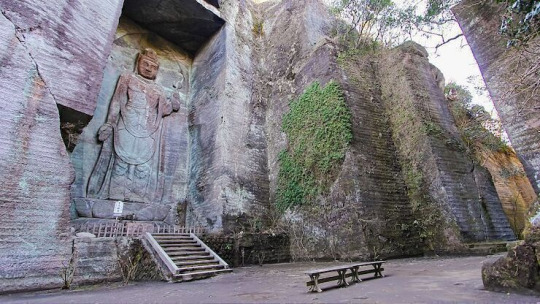
Mt. Nokogiri - Hyaku-Shaku Kannon carved into stone cliff
Mt. Nokogiri is named for the zigzag shape of a traditional handsaw that its topography resembles. Along with Mt. Kanozan and Mt. Kiyosumi, Mt. Nokogiri is one of Chiba's three most famous mountains. It stands at 330 meters high and features a grand lookout point as well as a temple complex containing one of Japan's largest Buddhas. The mountain is bare granite and has been a quarry since the Edo Period, providing stones for many of Tokyo's most iconic sites, such as Yasukuni Shrine and Waseda University. You can reach the top by an easy hike or via a ropeway to the top. Hell Lookout (地獄のぞき) is a lookout point at the top of the mountain that hangs over the edge of the cliff and offers a stunning view of Tokyo Bay, the Pacific Ocean, and the distant forests and hills of the Boso Peninsula, and on clear days, Mt. Fuji.
At the southern base of Mt. Nokogiri is Nihonji Temple (日本寺), an officially designated Important Cultural Property. There's a stairway leading from the top of the mountain down to the vast, picturesque Soto Zen Buddhist temple that dates back 1300 years and is still used to train young monks today. A giant daibutsu, or Buddha statue, is carved into the granite on the side of Mt. Nokogiri about midway up the mountain. It is 31 meters high and one of Japan's largest Buddhas, even larger than Kamakura's famous daibutsu at Kotokuin Temple. The statue was built to pray for world peace and most of the statue was carved over three years beginning in 1780.
In addition to the giant daibutsu, there are around 1500 small statues of various Buddhist deities around the temple grounds. Unfortunately, many of the smaller statues were beheaded during the anti-Buddhist movement that accompanied the Meiji Restoration, but there are ongoing efforts to repair them. This part of Nihonji was a spiritual sanctuary built over 21 years in the 18th century by craftsman Ono Kangoro and his students. Towards the top of the mountain stands a 30-meter tall Hyaku-Shaku Kannon, depicting the Buddhist Goddess of Mercy. Carved in 1966 into a stone cliff, it is dedicated to those who died in wars, of sickness or in accidents. The Kannon is also worshiped as a protector of transportation due to its protected location surrounded by rocks.
Regional Cuisine - 郷土料理 Sangayaki - さんが焼き

Sangayaki (source)
Namerou and sangayaki are well-known Chiba dishes, especially along the Bōsō Peninsula. Namerou (なめろう) is a dish usually made of minced horse mackerel and sardine mixed with miso, perilla leaves, and leek. When grilled and wrapped in perilla leaves, it is called sangayaki (さんが焼き). The name "namerou" may have come from the fact that namerou is so good that you want to lick your plate clean (nameru means to lick). The name "sangayaki" may be from the fact that the fishermen ate the dish along a river tributary, or sanga, and the word yaki means to grill (like yakisoba or yakitori). Namerou can be cooked in other ways, such as being shaped and grilled like a burger, or being coated in breadcrumbs and fried.
Chiba Dialect・Chiba no hougen・千葉の方言
Note: Chiba dialect is sometimes called Bōsō-ben (房総弁), after the peninsula. Chiba dialect is actually a family of three dialects: Bōshū-ben (房州弁), Tōsō-ben 東総弁, and Noda-ben (野田弁).
Bōshū-ben (房州弁)
1. おいねえ oinee not good
はしけえでおいねえや (hashikee de oinee ya)
Standard Japanese: かゆくていけないよ (kayukute ikenai yo)
English: This itches so badly
2. くわっせえ kuwassee please eat (command)
ばーさんほら、わーかでいーがらくわっせぇよ (baa-san hora, wa-ka de iigara kuwassei yo)
Standard Japanese: おばあさんほら、少しでいいから召し上がってよ (obaasan hora, sukoshi demo ii kara meshi agate yo)
English: Grandma, come on, please just eat a little bit
3. やんべえ yanbee health; condition (often used in a greeting)
いいやんべえだねえ (ii yanbee da nee)
Standard Japanese: こんにちは (konnichiwa)
English: Hello; Good day (lit. "you are in good health today")
Tōsō-ben 東総弁
1. あじょうだぁ ajyou daa how is it
あじょうだぁ? (ajyou daa?)
Standard Japanese: どうですか? (dou desu ka?)
English: How is it?
2. ねっけぇ nekkee warm
今日はずいぶんとねっけぇね (kyou wa zuibun to nekkee ne)
Standard Japanese: 今日はずいぶんと暖かいね (kyou wa zuibun to atatakai ne)
English: Today is fairly warm, isn't it?
3. わんらー wanraa you (informal, not very polite)
わんらーよー!んなことやってねーよ! (wanraa you! 'n na koto yatte nee yo!)
Standard Japanese: あなたねえ!そんな事しないでよ! (anata nee! sonna koto shinai de yo!)
English: Hey you! Stop doing that!
Noda-ben (野田弁)
1. こわい kowai difficult, taxing, bothersome
風邪ひいででまーだこわいだよなぁ (kaze hiide de maa-da kowai da yo naa)
Standard Japanese: 風邪を引いていてまだ身体がだるいんだよね (kaze wo hiite ite mada karada ga daruin da yo ne)
English: I have a cold and my body still feels listless
2. はらくち harakuchi full
はらくちだよなぁ (harakuchi da yo naa)
Standard Japanese: お腹いっぱいだよね (onaka ippai da yo ne)
English: I'm full
3. やっこら yakora soon
やっこらいくべ (yakora iku be)
Standard Japanese: そろそろいこうか (sorosoro ikou ka)
English: Shall we go soon?
#japanese prefectures#日本語#japanese#japanese language#japanese langblr#langblr#studyblr#都道府県#千葉県#chiba
37 notes
·
View notes
Text
im watching 47 meters down these girls are lowkey pissing me off. sort of annoying. also a great white wouldn't eat the camera 🙄tiger maybe
7 notes
·
View notes
Text
Interview with Jupp Heynckes about Thomas Müller
By: Kicker

Mr. Heynckes, Thomas Müller scored for FC Bayern for the 499th time in an official match in the recent Bundesliga match against SC Freiburg. He has 235 goals and 264 assists. You knew this player as a coach in Munich from April 28 to June 30, 2009 and in the two seasons 2011/12 and 2012/13. Why does Müller stand out?
To judge this player and appreciate his record, you have to see the full picture of Thomas Müller. Thomas is a traveler between worlds on the football field, which means that he is neither a striker nor a defensive midfielder, but an attacking midfielder endowed with a special goal-scoring instinct and a gift that is granted to very few players: he has a fundamental endurance and exceptional speed. This combination has always distinguished him physically. Moreover, he is an absolute team player who always and without exception puts himself at the service of the team.
Does this also characterize Müller as a person?
Yes, he is authentic, sympathetic, empathetic, funny, original with his sayings, optimistic, positive and able to lead. Thomas doesn't duck away in awkward moments, he always faces up and has a clear, decided opinion on football and the circumstances in a team. That's why I've always spoken highly of Thomas Müller, because he's an exceptional player, not only because of his footballing qualities, but also because of his personality. I like to compare him with my former teammate Hacki Wimmer, who was just as strong a midfielder as Thomas at Borussia Mönchengladbach and also gave everything for the team. He was self-sacrificing on the defensive end, moving forward, but not as goal-threatening as Thomas. Today, Thomas is a mature professional who knows for himself when he has played well and not so well, when he needs to be critical or hold back publicly. He is now in the late autumn of his career, which is quite normal when you have 300,000 kilometers in your legs and are 34 years old.
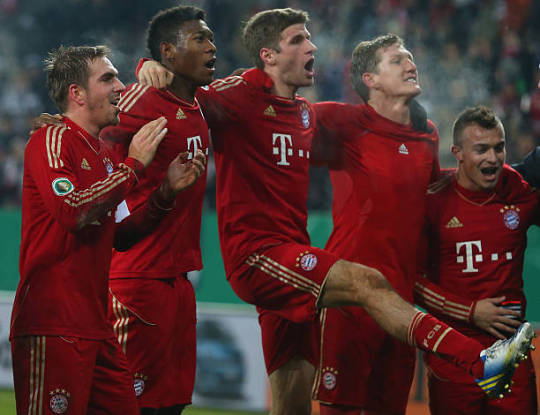
Thomas Müller describes himself as an Raumdeuter. Does he have this particular feel for a promising goal situation?
Yes, he intuitively recognizes situations in the game that could be dangerous for a goal. A strong runner and hard worker, he also goes where he thinks he needs to be present and finishes. With his now very good eye, he has great peripheral vision, plus calmness on the ball, so he plays precise passes and hits very good crosses. Thomas doesn't stand out as a footballing giant, but his overall image could be of a great painter like the Italian Rafael.
What was Thomas Müller like in personal interactions?
He was always accessible in communication, ready to talk and receptive. He understands football as a game, recognizes currents in a team and sees through the mechanisms outside. With Bastian Schweinsteiger and Philipp Lahm, he mediated within the team and forced self-cleaning processes before the coach had to take action. It's a gift when you have players like that as a coach.

In the Bundesliga, Müller, who made his debut in a 2-2 draw with Hamburger SV on August 15, 2008, has recorded 200 assists and 144 goals in 448 matches and 33,089 minutes, he needs 96 minutes for a scoring point, so he manages to score or set up a goal in almost every league match. How is this consistency possible?
First, he was very rarely injured, so he had continuity in his career. Then he has the ability to anticipate, he foresees developments on the pitch. When Franck Ribery and Arjen Robben used to go off on the wings or Kingsley Coman, Serge Gnabry or Leroy Sané do it today, Thomas sprints off from deep or instinctively adapts his position to requirements when he's already in the penalty area, he goes into the five-meter area or pulls back from there toward the penalty spot. He also likes to orient himself towards the second post. He has this behavior down pat and has also perfected it. Thomas has it all in his blood.
Under you as coach, Müller scored 47 goals in 135 appearances over 9754 minutes, plus 53 assists, making exactly 100 scorer points. Where did you see his ideal position?
Thomas is a highly intelligent player whom I used mainly as a forward midfielder or second striker. He could also play on the right side and accepted this role without grumbling. He got to grips with this task and then came through there as well. The optimal place for him was behind the striker.
Müller set up by far the most goals for Robert Lewandowski: 64, including 48 in the Bundesliga. Why did Müller and Lewandowski harmonize so well?
It worked so well with Thomas and Robert Lewandowski because Lewy recognized and sensed exactly when he needed to break away from his opponent - at the precise moment when the ball had left Thomas' foot, and never before. This interplay was based on the intuition of the two, it was blind understanding. Thomas hit the crosses exactly the way Lewy needed them: the striker had to go forward, run or sprint into the crosses or put-ins, often with prior backward body deception.

Were Müller and Lewandowski the most effective striker duo in Bundesliga history?
Every time is different. Of course, they were a great pair, but Thomas played just as efficiently with Mario Gomez or Mario Mandzukic. However, Lewy has already benefited a lot from Thomas.
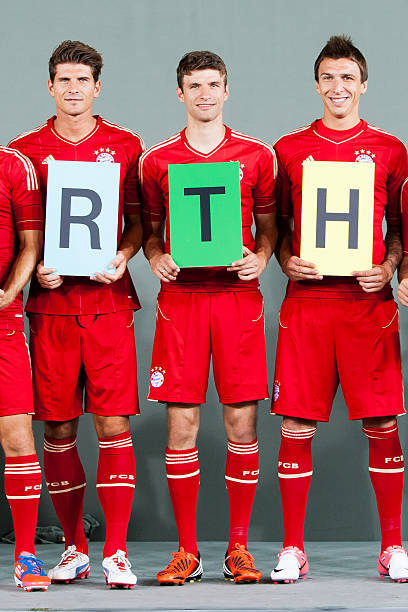
Under Pep Guardiola, Müller collected at least 40 scorer points in every game, and in 2015/16 his best mark was 45. Does Müller need more space for his game or does it help him more when things are tight up front?
When Thomas has space, that's an advantage for him because he's also very fast. But since he is a very skilled player, he knows how to adjust to all conditions. In general, he moves very well thanks to his immense running strength and is always playable. When he comes under pressure there, he doesn't take the ball but just lets it clatter. His passes have the right sharpness and precision, they also get onto the right foot of the teammate - many professionals lack this gift. Thomas plays simple football, not fancy.
87 scorer points are the best score for a German player in the Champions League. FC Barcelona is the foreign club against which Müller scored the most points. In nine duels, he scored eight goals and served to two goals. In the semifinal before winning the title in 2013, Müller scored the 1-0 and 4-0 at home, and he set up the 3-0 by Mario Gomez. In the second leg, he scored the 3:0. What does this data say about Müller's international class?
For Thomas, the games in the Champions League were always highlights, and he saw the duels with Real Madrid or FC Barcelona as a major challenge. His special motivation was there to be felt. He knew how to adapt to his opponents, and he knew exactly when he needed to be even more focused. That's why this international top score comes as no surprise to me.
Was he nervous at any point?
No. Rather highly concentrated and well prepared, tense. Anyone who has been German champion twelve times like Thomas is no longer nervous.
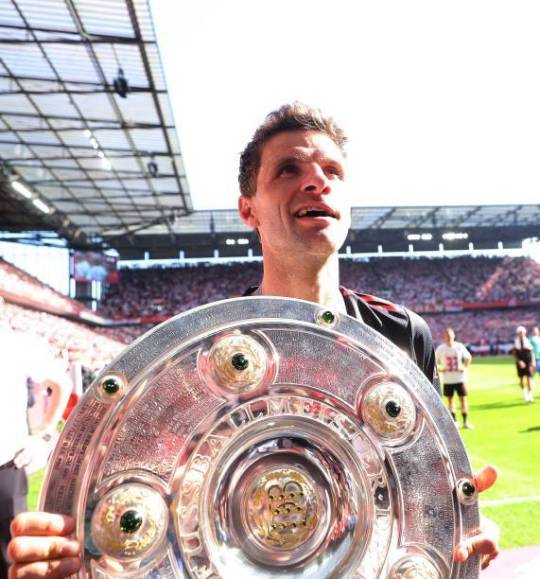
Did you see Müller more as the final provider or the enforcer?
I have always seen the whole football player Thomas Müller, both elements for the offense distinguish. In addition, he was always driven by an immense will to perform, the utmost professionalism. Even if he exudes a certain lightness on the outside, in truth he is totally focused. That's why I always had such a high opinion of him.
Müller scored 149 of his 235 goals with his right foot, and he also scored with his chest - against Bochum in 2009/10 - or with his left upper arm against Hannover in the 2013/14 Cup. Is Müller underestimated because of his sometimes seemingly clumsy movements?
What I said before about him as a footballer makes any answer to this question superfluous.
Müller didn't have it easy with every coach. Did you also have doubts about him at times?
I never had any doubts about Thomas Müller. I got to know him in 2009. Back then, we still managed to reach the Champions League in the six weeks we worked together at the end of the season. After the season, we played six friendly matches, six days in a row. Thomas played every one of those games. It was amazing. After that, I transferred to Bayer Leverkusen and called Hermann Gerland in Munich and said, "Hermann, I want Thomas." Hermann replied, "You're crazy. I've already talked to Louis van Gaal and told him that Thomas is a good kid we have to promote." I then dropped the courting of Thomas.
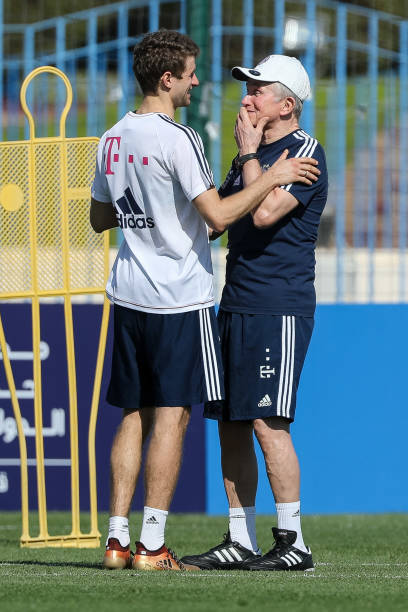
Müller was never Footballer of the Year. Is his value not appreciated accordingly?
Has he really never been Germany's football player of the year?
Never.
That is an oversight on the part of the jury. I would like to join this group (laughs), my vote would go to Thomas. He would have deserved this award 100 percent. For me, he is exceptional and one of the best players in the history of FC Bayern, which is rich in great players and to which he has been loyal throughout his career. It is a gift for any club to have such a player. I have always held him in immense esteem, Thomas Müller is unique. What he has achieved in football so far is a magnificent, admirable lifetime achievement. And once he steps off the big football stage, I will miss him. When he plays, Thomas is always an eye-catcher. There will never be another player like him: Just as there will be no more Franz Beckenbauer or Gerd Müller, there will be no more Thomas Müller.

#I have to confess that I cried reading this interview#jupp heynckes#thomas müller#fc bayern münchen#interview
40 notes
·
View notes
Text

WADDYA MEAN THEY LOST THE WHOLE CRANE????

oh, nope, I do NOT like the premise of this film, NOPE
10 notes
·
View notes
Text
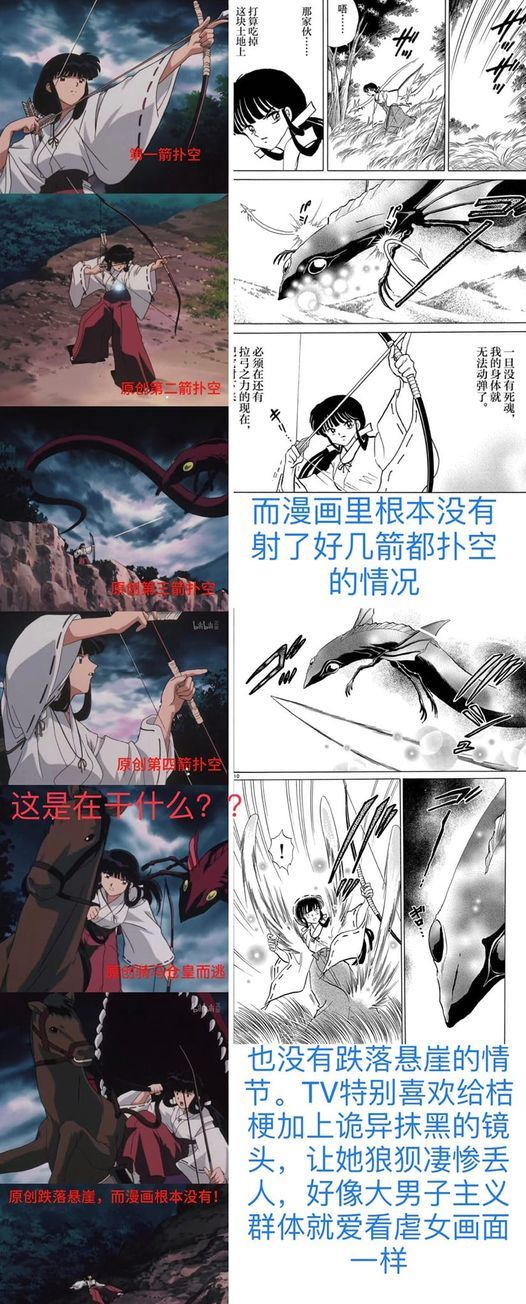
Resuming the dynamics of the morning, this time we are at Chapter 171 of the manga, corresponding to Episode 47 of the anime.
Quick summary, Naraku tries to eliminate Kikyo permanently with a giant soul collector, so far so good, both versions are the same plan, the change lies in the showdown of Kikyo vs the red collector snake.
Here it is not shown, but at the beginning in the animated version, Kikyo's first reaction is to run away from the giant collector, that not counting that he stole a horse to be able to escape, the pursuit goes on for several kilometers until finally she stops near a precipice, Kikyo decides fight against the soul collector but all her arrows lack enough spiritual power, so when impacting the enemy this receives no damage, even shows as if she did not have enough ability with the bow, something illogical for she was able to seal a a person on the move while his arm was shattered. Seeing that her attacks are useless Kikyo decides to run away again on the horse but the soul collector gets too close to her and knocks her down, dropping her off a cliff, the latter is too much if you ask me.
In the manga is something completely different, for Kikyo instead of just running away, she walks to get away from the yokai, all this while fighting face to face against him, that is at no time ran away as his counterpart from the anime, here the snake dodged the attacks of Kikyo, by that is that she was not able to defeat him, not to mention that in the end she steals countless souls, which leaves her weak and without the possibility to defend herself, in the anime instead, she simply falls off the horse and still walks several meters more until she meets Inuyasha, something that, as I explained to them, it is illogical because if I really did not have the strength to fight because he lost many souls, also he would not have been able to ride the horse to escape, that is, Kikyo in the anime lost due to lack of ability, not because he was weak, as if he was in the manga.
We finally have one of my favorite quotes exclusive from the manga. Since Kikyo had recovered, she asks Inuyasha what he was doing there, to which he replies that he could ask her the same question, Kikyo simply replies that when she was chased by the monster hoarder she started walking and walking and ended up there, in the village where he was born, grew up and finally met him.
Next comes the infamous knife scene that we all know in the anime and the beautiful hug scene in the manga.
--Sammi Sweetheartts Bonnet.
#inukik#inuyasha#inuyasha kikyo#kikyo#inukyo#inuyasha x kikyo#pro inukik#kikyou#pro kikyo#priestess kikyo
14 notes
·
View notes
Text
Good Omens, political and social satire
We all love Good Omens.
One of the things, though, which was missing from the TV adaptations was the hilarious, Douglas Adams-esque vignettes. I would have loved to see some updates about modern life, although the '90s snapshots are still funny and relevant. Given the presence of corporate mergers, lack of communication between managers, owners and workers, and a recent (and well publicised) problem with a commercial transportation device whose quality suddenly dipped when they merged with a more cutthroat company, I thought I should remind everyone of this.
Several thousand miles away, at almost the same moment as Anathema was staring at her spirals, the pleasure cruiser Morbilli was aground in three hundred fathoms of water.
For Captain Vincent, this was just another problem. For example, he knew he should contact the owners, but he never knew from day to day -or from hour to hour, in this computerized world-actually who the current owners were.
Computers, that was the bloody trouble. The ship's papers were computerized and it could switch to the most currently advantageous flag of convenience in microseconds. Its navigation had been computerized as well, constantly updating its position by satellites. Captain Vincent had explained patiently to the owners, whoever they were, that several hundred square meters of steel plating and a barrel of rivets would be a better investment, and had been informed that his recommendation did not accord with current cost/benefit flow predictions.
Captain Vincent strongly suspected that despite all its electronics the ship was worth more sunk than afloat, and would probably go down as the most perfectly pinpointed wreck in nautical history.
By inference, this also meant that he was more valuable dead than alive.
He sat at his desk quietly leafing through International Maritime Codes, whose six hundred pages contained brief yet pregnant messages designed to transmit the news of every conceivable nautical eventuality across the world with the minimum of confusion and, above all, cost.
What he wanted to say was this: Was sailing SSW at position 33°N 47° 72'W. First Mate, who you may recall was appointed in New Guinea against my wishes and is probably a head-hunter, indicated by signs that something was amiss. It appears that quite a vast expanse of seabed has risen up in the night. It contains a large number of buildings, many of which appeared pyramid-like in structure. We are aground in the courtyard of one of these. There are some rather unpleasant statues. Amiable old men in long robes and diving helmets have come aboard the ship and are mingling happily with the passengers, who think we organized this. Please advise.
His questing finger moved slowly down the page, and stopped. Good old International Codes.
They'd been devised eighty years before, but the men in those days had really thought hard about the kind of perils that might possibly be encountered on the deep.
He picked up his pen and wrote down: "XXXV QVVX."
Translated, it meant: "Have found Lost Continent of Atlantis. High Priest has just won quoits contest."
7 notes
·
View notes